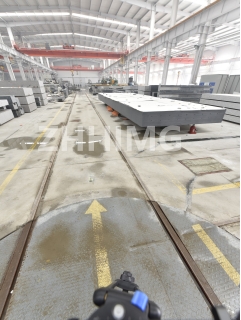Granite gas bearings have been widely used in CNC equipment due to their excellent stability, low maintenance, and long service life. They can significantly improve machining accuracy and reduce machine downtime. However, installing and debugging granite gas bearings in CNC equipment requires special attention and skills. In this article, we will discuss how to install and debug granite gas bearings in CNC equipment.
Step 1: Preparation
Before installing the granite gas bearings, you need to prepare the CNC equipment and the bearing components. Make sure the machine is clean and free of any debris that may interfere with the installation process. Check the bearing components for any defects or damage, and ensure that they are all included. In addition, you need to acquire the appropriate tools for the installation, such as torque wrenches, Allen wrenches, and measuring devices.
Step 2: Installation
The first step in installing granite gas bearings is to mount the bearing housing onto the spindle. Make sure that the housing is aligned properly and tightly secured to prevent any movement during operation. Once the housing is mounted, the bearing cartridge can be inserted into the housing. Before inserting, check the clearance between the cartridge and the housing to ensure a proper fit. Then, carefully insert the cartridge into the housing.
Step 3: Debugging
After installing the granite gas bearings, it is essential to conduct a debugging process to identify any issues and adjust the system accordingly. Start by checking the clearance between the spindle and the bearings. A clearance of 0.001-0.005mm is ideal for the efficient operation of the bearings. Use a dial gauge to measure the clearance, and adjust it by adding or removing shims. Once you have adjusted the clearance, check the preload of the bearings. The preload can be adjusted by altering the air pressure in the bearings. The recommended preload for granite gas bearings is 0.8-1.2 bars.
Next, check the balance of the spindle. The balance should be within 20-30g.mm to ensure that the bearings operate efficiently. If the balance is off, adjust it by removing or adding weight to the unbalanced area.
Finally, check the alignment of the spindle. Misalignment can cause premature wear and damage to granite gas bearings. Use a laser or indicator to check the alignment and adjust it accordingly.
Step 4: Maintenance
Proper maintenance is essential to ensure the longevity and stability of granite gas bearings in CNC equipment. Regularly inspect the bearings for any wear or damage, and replace them if necessary. Keep the bearings clean and free of any debris or contaminants that may cause damage. Lubricate the bearings regularly according to the manufacturer's recommendations.
In conclusion, installing and debugging granite gas bearings in CNC equipment requires careful attention and skills. By following these steps and conducting regular maintenance, you can enjoy the benefits of these bearings for a long time, including improved accuracy, increased stability, and reduced downtime.
Post time: Mar-28-2024

